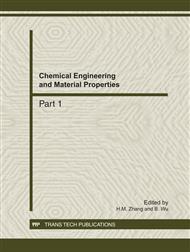[1]
M. R. Hoffmann, S. T. Choi, W. Martin, D. W. Bahnemann: Chem. Rev. Vol. 95(1995), p.69.
Google Scholar
[2]
A.L. Linsebigler, G. Lu, J.T. Yates: Chem. Rev. Vol. 95(1995), p.735.
Google Scholar
[3]
A. Fujishima, T.N. Rao, D.A. Truk: J. Photochem. Photobiol. C: Photochem. Rev. Vol. 1(2000), p.1.
Google Scholar
[4]
B.H. Wu, C.Y. Guo, N.F. Zheng, Z.X. Xie, G.D. Stucky: J. Am. Chem. Soc. Vol. 130(2008), p.17563.
Google Scholar
[5]
H.G. Yang, G. Liu, S.Z. Qiao, C.H. Sun, Y.G. Jin, S.C. Smith, J. Zou, H.M. Cheng, G.Q. Lu: J. Am. Chem. Soc. Vol. 131 (2009), p.4078.
Google Scholar
[6]
X. Han, Q. Kuang, M. Jin, Z. Xie, L. Zheng: J. Am. Chem. Soc. Vol. 131 (2009), p.3152.
Google Scholar
[7]
D.Q. Zhang, G.S. Li, X.F. Yang, J.C. Yu: Chem. Commun. Vol. (2009), p.4381.
Google Scholar
[8]
R. Asashi, T. Morikawa, T. Ohwaki, K. Aoki, Y. Taga: Science Vol. 293(2001), p.269.
Google Scholar
[9]
S.U.M. Khan, M. Al-shahry, Jr.W.B. Ingler: Science Vol. 297(2002), p.2243.
Google Scholar
[10]
T. Umebayashi, T. Yamaki, H. Itoh, K. Asai: Appl. Phys. Lett. Vol. 81(2002), p.454.
Google Scholar
[11]
(a) G. Liu, H.G. Yang, X. Wang, L. Cheng, J. Pan, G.Q. Lu, H. -M. Cheng: J. Am. Chem. Soc. Vol. 131 (2009), p.12868. (b) G. Liu, L.Z. Wang, C.H. Sun, Z.G. Chen, X.X. Yan, L.N. Cheng, H.M. Cheng, G.Q. Lu: Chem. Commun. Vol. 1383 (2009), p.1383.
DOI: 10.1039/b820483g
Google Scholar
[12]
M.H. Zhou, J.G. Yu: J. Hazard. Mater. Vol. 152 (2008), p.1229.
Google Scholar
[13]
F. Dong, W.R. Zhao, Z.B. Wu: Nanotechnology Vol. 19 (2008), p.365607.
Google Scholar
[14]
Y.W. Wang, Y. Huang, W.K. Ho, L.Z. Zhang, Z.G. Zou, S.C. Lee: J. Hazard. Mater. Vol. 169 (2009), p.77.
Google Scholar
[15]
Y.H. Ao, J.J. Xu, D.G. Fu, C.W. Yuan: Microporous Mesoporous Mater. Vol. 122 (2009), p.1.
Google Scholar
[16]
Q. Xiao, L.L. Ouyang: Journal of Alloys and Compounds Vol. 479(2009), p. L4.
Google Scholar
[17]
W.J. Ren, Z.H. Ai, F.L. Jia, L.Z. Zhang, X.X. Fan, Z.G. Zou: Appl. Catal. B: Environ. Vol. 69 (2007) , p.138.
Google Scholar
[18]
J. Ananpattarachai, P. Kajitvichyanukul, S. Seraphind: J. Hazard. Mater. Vol. 168 (2009) , p.253.
Google Scholar
[19]
H.X. Li, G.S. Li, J. Zhu, Y. Wan: Journal of Molecular Catalysis A: Chemical Vol. 226 (2005) , p.93.
Google Scholar
[20]
Y. Cong, J.L. Zhang, F. Chen, M. Anpo : J. Phys. Chem. C Vol. 111 (2007) , p.6976.
Google Scholar
[21]
H.X. Li, X.Y. Zhang, Y.N. Huo, J. Zhu : Environ. Sci. Technol. Vol. 41 (2007), p.4410.
Google Scholar
[22]
C. Lettmann, K. Hildenbrand, H. Kisch, W. Macyk, W.F. Maier: Appl. Catal. B: Environ. Vol. 32 (2001), p.215.
Google Scholar
[23]
D. Li, H. Haneda, S. Hishita, N. Ohashi: Mater. Sci. Eng. B Vol. 117 (2005), p.67.
Google Scholar


